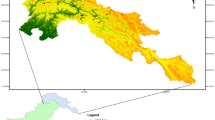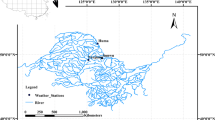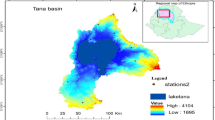Abstract
Global warming has brought great pressure on the environment and livelihood conditions in Sudan and South Sudan. It is desirable to analyze and predict the change of critical climatic variables, such as temperature and precipitation, which will provide valuable reference results for future water resources planning and management in the region. The aims of this study are to test the applicability of the Long Ashton Research Station Weather Generator (LARS-WG) model in downscaling daily precipitation and daily maximum (Tmax) and daily minimum (Tmin) temperatures in Sudan and South Sudan and use it to predict future changes of precipitation; Tmin and Tmax for nine stations in Sudan and South Sudan are based on the SRA2 scenario of seven General Circulation Models (GCMs) outputs for the periods of 2011–2030, 2046–2065, and 2080–2099. The results showed that (1) the LARS-WG model produces good performance in downscaling daily precipitation and excellent performance in downscaling Tmax and Tmin in the study region; (2) downscaled precipitation from the prediction of seven GCMs showed great inconsistency in these two regions, which illustrates the great uncertainty in GCMs' results in the regions; (3) predicted precipitation in rainy season JJA (June, July, and August) based on the ensemble mean of seven GCMs showed a decreasing trend in the periods of 2011–2030, 2046–2065, and 2080–2099 in Sudan; however, an increasing trend can be found in SON (September, October, and November) in the future; (4) precipitation in South Sudan has an increasing trend in most seasons in the future except in MAM (March, April, and May) season in 2011–2030; and (5) predictions from seven GCMs showed a similar and continuous increasing trend for Tmax and Tmin in all three future periods, which will bring severe negative influence on improving livelihoods and reducing poverty in Sudan and South Sudan.








Similar content being viewed by others
References
Allen, D.M., Cannon, A.J., Toews, M.W., Scibek, J. (2010) Variability in simulated recharge using different GCMs. Water Resources Research 46.
Alvi SH (1994) Climatic changes, desertification and the Republic of Sudan. GeoJournal 33(4):393–399
Alvi SH, Elagib NA (1996) Study of hydrology and drought in the flood region of Sudan. Water Int 21(2):76–82
Ayoub AT (1999) Land degradation, rainfall variability and food production in the Sahelian zone of the Sudan. Land Degradation Dev 10(5):489–500
Bell MA, Lamb PJ (2006) Integration of weather system variability to multidecadal regional climate change: the West African Sudan-Sahel zone, 1951–98. J Climate 19(20):5343–5365
Biasutti M, Giannini A (2006) Robust Sahel drying in response to late 20th century forcings. Geophys Res Lett 33(11)
Biasutti M, Held IM, Sobel AH, Giannini A (2008) SST forcings and Sahel rainfall variability in simulations of the twentieth and twenty-first centuries. J Climate 21(14):3471–3486
Cadet D, Nnoli N (1987) Water vapour transport over Africa and the Atlantic Ocean during summer 1979. Q J R Meteorol Soc 113(476):581–602, Quarterly Journal of the Royal Meteorological Society 113(476): 581–602
Camberlin P (1995) June–September rainfall in north-eastern Africa and atmospheric signals over the tropics: a zonal perspective. Int J Climatol 15:773–783
Caminade C, Terray L, Maisonnave E (2006) West African monsoon response to greenhouse gas and sulphate aerosol forcing under two emission scenarios. Clim Dyn 26(5):531–547
Druyan LM (2011) Studies of 21st-century precipitation trends over West Africa. Int J Climatol 31(10):1415–1424
Elagib NA (2010) Trends in intra- and inter-annual temperature variabilities across Sudan. Ambio 39(5–6):413–429
Elagib NA (2011a) Changing rainfall, seasonality and erosivity in the hyper-arid zone of Sudan. Land Degrad Dev 22(6):505–512
Elagib NA (2011b) Evolution of urban heat island in Khartoum. Int J Climatol 31(9):1377–1388
Eldredge E, Khalil SE, Nicholds N, Abdalla AA, Rydjeski D (1988) Changing rainfall patterns in western Sudan. J Climatol 8(1):45–53
Eltahir EAB (1989) A feedback mechanism in annual rainfall, Central Sudan. J Hydrol 110(3–4):323–334
Fontaine B, Roucou P, Trzaska S (2003) Atmospheric water cycle and moisture fluxes in the West African monsoon: mean annual cycles and relationship using NCEP/NCAR reanalysis. Geophys Res Lett 30(3)
Funk C, Eilerts G, Verdin J, Rowland J, Marshall M (2011) A climate trend analysis of Sudan. U.S. Geol Surv Fact Sheet 2011–3072:1–6
Goyal MK, Ojha CSP (2012) Downscaling of precipitation on a lake basin: evaluation of rule and decision tree induction algorithms. Hydrol Res 43(3):215–230
Hashmi MZ, Shamseldin AY, Melville BW (2011) Comparison of SDSM and LARS-WG for simulation and downscaling of extreme precipitation events in a watershed. Stoch Env Res Risk A 25(4):475–484
Hulme M, Doherty R, Ngara T, New M, Lister D (2001) African climate change: 1900–2100. Climate Research 17(2):145–168
Kamga AF, Jenkins GS, Gaye AT, Garba A, Sarr A, Adedoyin A (2005) Evaluating the National Center for Atmospheric Research Climate System model over West Africa: present-day and the 21st century A1 scenario. J Geophys Res-Atmos 110(D3)
Kamga FM (2001) Impact of greenhouse gas induced climate change on the runoff of the Upper Benue River (Cameroon). J Hydrol 252(1–4):145–156
Kim U, Kaluarachchi JJ, Smakhtin VU (2008) Generation of monthly precipitation under climate change for the upper blue nile river basin, Ethiopia. J Am Water Resour Assoc 44(5):1231–1247
Lamb P (1978a) Case studies of Tropical Atlantic surface circulation patterns during recent Subsaharan weather anomalies: 1967 and 1968. Mon Wea Rev 106:482–491
Lamb P (1978b) Large-scale Tropical Atlantic surface circulation patterns associated with Subsaharan weather anomalies. Tellus Ser A-Dyn Meteorol Oceanogr 30(240–251)
Luo QY, Bellotti W, Hayman P, Williams M, Devoil P (2010) Effects of changes in climatic variability on agricultural production. Clim Res 42(2):111–117
Mariotti, L., Coppola, E., Sylla, M.B., Giorgi, F., Piani, C. (2011) Regional climate model simulation of projected 21st century climate change over an all-Africa domain: comparison analysis of nested and driving model results. Journal of Geophysical Research-Atmospheres 116.
Olsson J, Willén U, Kawamura A (2012) Downscaling extreme short-term regional climate model precipitation for urban hydrological applications. Hydrol Res 43(4):341–351
Osman YZ, Shamseldin AY (2002) Qualitative rainfall prediction models for central and southern Sudan using El Niño–Southern Oscillation and Indian Ocean sea surface temperature indices. Int J Climatol 22(15):1861–1878
Osman YZ, Shamseldin AY, Abdo GM (2001) El Niño–Southern Oscillation and rainfall variability in central and southern Sudan. Water Int 26(2):177–184
Palmer T (1986) Influence of the Atlantic, Pacific and Indian oceans on Sahel rainfall. Nature 322:251–253
Peterson TC, Vose RS (1997) An overview of the Global Historical Climatology Network temperature database. Bull Am Meteorol Soc 78(12):2837–2849
Qian BD, Hayhoe H, Gameda S (2005) Evaluation of the stochastic weather generators LABS-WG and AAFC-WG for climate change impact studies. Clim Res 29(1):3–21
Racsko P, Szeidl L, Semenov M (1991) A serial approach to local stochastic weather models. Ecol Model 57(1–2):27–41
Segui PQ, Ribes A, Martin E, Habets F, Boe J (2010) Comparison of three downscaling methods in simulating the impact of climate change on the hydrology of Mediterranean basins. J Hydrol 383(1–2):111–124
Semenov, M.A. (2002) LARS-WG: a stochastic weather generator for use in climate impact studies. http://www.rothamsted.ac.uk/mas-models/larswg.php User Manual: 1–27.
Semenov MA, Barrow EM (1997) Use of a stochastic weather generator in the development of climate change scenarios. Clim Chang 35(4):397–414
Semenov MA, Brooks RJ, Barrow EM, Richardson CW (1998) Comparison of the WGEN and LARS-WG stochastic weather generators for diverse climates. Clim Res 10(2):95–107
Semenov MA, Stratonovitch P (2010) Use of multi-model ensembles from global climate models for assessment of climate change impacts. Clim Res 41(1):1–14
Wilby RL, Wigley TML (1997) Downscaling general circulation model output: a review of methods and limitations. Prog Phys Geogr 21(4):530–548
Xu C-Y, Widén E, Halldin S (2005) Modelling hydrological consequences of climate change - progress and challenges. Adv Atmos Sci 22(6):789–797
Xu C-Y, Zhang Q, El Tahir MEH, Zhang Z (2010) Statistical properties of the temperature, relative humidity, and net solar radiation in the Blue Nile–eastern Sudan region. Theor Appl Climatol 101(3–4):397–409
Xu CY (1999) From GCMs to river flow: a review of downscaling methods and hydrologic modelling approaches. Prog Phys Geogr 23(2):229–249
Zhang Z, Xu C-Y, El-Tahir M, Cao J, Singh V (2012) Spatial and temporal variation of precipitation in Sudan and their possible causes during 1948–2005. Stoch Environ Res Risk Assess 26(3):429–442
Acknowledgments
The study is financially supported by the National Natural Science Fund of China (51279138) and the Research Council of Norway with project number 171783 (FRIMUF). Metrological daily data were downloaded freely from the Global Historical Climatology Network-Daily database (http://www.ncdc.noaa.gov/oa/climate/ghcn-daily/).
Author information
Authors and Affiliations
Corresponding author
Rights and permissions
About this article
Cite this article
Chen, H., Guo, J., Zhang, Z. et al. Prediction of temperature and precipitation in Sudan and South Sudan by using LARS-WG in future. Theor Appl Climatol 113, 363–375 (2013). https://doi.org/10.1007/s00704-012-0793-9
Received:
Accepted:
Published:
Issue Date:
DOI: https://doi.org/10.1007/s00704-012-0793-9




